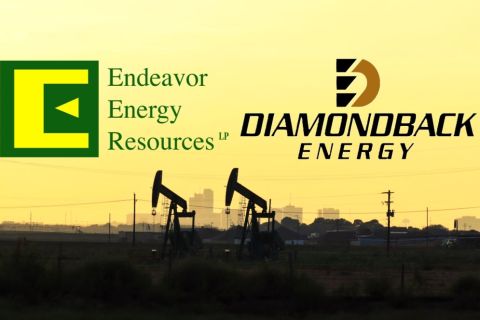They call it prolific, extraordinary, world-class and amazing. Those are just a handful of the words used to describe the incredible rise of the Marcellus shale, the star of the Appalachian “beast of the east” that continues to astonish and exceed industry expectations.
Growing at a dizzying pace, the Marcellus has the midstream struggling to keep up. And if the necessary infrastructure isn’t built quickly, it will continue to hamper production. For now, though, production figures continue to soar.
“It’s amazing. It’s absolutely amazing,” Rick Notarianni, a Bentek Energy analyst, said during Platts’ recent North American Oil and Gas Supply Chain conference. “Every time we think it’s slowing down, something else happens. Every time we discount it and get concerned about the Marcellus’ growth, it keeps hurdling beyond our expectations.”
Natural gas production in the Marcellus—running mainly through Pennsylvania, West Virginia and New York—has grown six-fold since 2009, thanks largely to increased dry gas production in northeastern Pennsylvania. Total gas production in the Marcellus has reached nearly 13 billion cubic feet (Bcf) per day, according to recent U.S. Energy Information Administration data.
If the Marcellus were a country, it would join the ranks of Qatar and Saudi Arabia as the largest gas-producing regions in the world.
To keep pace with this tremendous growth, midstreamers are working feverishly to improve infrastructure, expand pipeline capacity and boost the play’s storage, processing and takeaway systems.
“Our estimation is this is going to grow no matter what and push all the pipelines in the area to capacity,” said Notarianni. “If you can build the pipelines, this will probably grow to 20 Bcf a lot faster than everyone’s guessing.”
Shortage slowdown
A lack of midstream infrastructure could be keeping the Marcellus from reaching its full potential. Though production is increasing quickly, rapid growth has its drawbacks. Since the midstream hasn’t yet caught up with the sudden growth of the Marcellus, production is being curtailed as operators wait for the necessary infrastructure to be constructed.
By Wood Mackenzie’s estimates, about 340 wells are awaiting completion throughout the Marcellus. It adds that gas is currently being restricted at the wellhead to the tune of about 1.4 Bcf equivalent per day. But of course, volumes are still huge.
“Production is now over 10 Bcf per day and with more than 80,000 possible remaining well locations in the play, the Marcellus is expected to dominate the U.S. gas supply story for the foreseeable future,” said Matt Woodson, an upstream research analyst with Wood Mackenzie, in a recent report.
Meantime, work continues on building out the backbone of the region’s infrastructure, says David Spigelmyer, president of the Marcellus Shale Coalition. As production grows, he says significant capital investments are being made on pipelines to get gas downstream into the interstate system and off to consuming regions.
“There’s a lot of work being done by members,” Spigelmyer tells Midstream Business. “Are there still areas that are in need of pipeline infrastructure? Certainly. There’s probably a fiveto seven-year build-out to get that infrastructure in place. Our members are working every day to get it built so we can collect gas from those wells and get it to the marketplace.”
Building out
There’s still a long way to go. According to an Interstate Natural Gas Association of America (INGAA) study, more than 43 Bcf per day of incremental mainline capacity will be needed through 2035. More pipeline laterals, gas storage fields and processing facilities will be needed, too. About $2.6 billion is forecast to be spent annually on gathering and processing systems, and timeliness is crucial, says Chad Zamarin, chief operating officer of NiSource Midstream Services.
“In the midstream space, the greatest challenge is implementing large-scale pipeline, processing and storage infrastructure projects that provide access to demand centers in the Northeast on a pace that satisfies the producers’ timeline,” Zamarin tells Midstream Business. “If obstacles to building the necessary processing, gathering and pipeline infrastructure arise, growth in Marcellus production will be delayed.”
NiSource is among the companies leading the infrastructure charge. A few other heavy-hitters include MarkWest Energy Partners LP, Energy Transfer and Williams. NiSource has invested nearly $500 million in Marcellus and Utica gathering and processing systems so far, and plans to spend more than $1 billion in the region during the coming years.
The Majorsville gathering system was NiSource Midstream’s first infrastructure project and is part of the first integrated gathering and processing system serving Marcellus production in southwest Pennsylvania and northern West Virginia. During the project, NiSource Midstream repurposed existing assets and expedited the gathering and delivery of about 250,000 dekatherms of gas per day. This allowed NiSource to gather and deliver liquid-rich Marcellus gas in southwestern Pennsylvania and northern West Virginia to the MarkWest Liberty Majorsville processing plant. Residue gas from the processing plant is delivered by NiSource into the Columbia Gas and Texas Eastern interstate pipeline systems.
In 2012, NiSource Midstream launched a $165 million investment in the Big Pine gathering system—57 miles of 20- and 24-inch gathering pipeline, extending through the heart of the Marcellus shale in Butler, Allegheny, Armstrong, Indiana and Westmoreland counties.
“The construction of the Big Pine system involved newly built pipeline and several major river crossings, and NiSource Midstream met an extremely aggressive schedule to ensure that gas would flow to market in the first quarter of 2013,” says Zamarin. “This project of exceptional size and scope was delivered in 12 months—an unprecedented accomplishment in the industry.”
As well, NiSource engaged in two joint ventures (JVs) with Hilcorp Energy Co. affiliates. The first was an upstream development partnership resulting in a substantial combined acreage position across a six-county area in northeast Ohio and western Pennsylvania. The second JV resulted in the formation of Pennant Midstream LLC, a 50/50 partnership between the midstream affiliate of Hilcorp Energy Co., Harvest Pipeline and NiSource. It was formed to build the Hickory Bend gathering system and processing plant, anchored by the upstream joint venture acreage position in the AMI. The $375 million investment is currently under construction, with NiSource managing the construction and acting as operator.
The Hickory Bend project includes approximately 55 miles of wet gas-gathering pipeline facilities in northeastern Ohio and western Pennsylvania, with capacity of more than 600 million cubic feet (MMcf) of gas per day, as well as a cryogenic natural gas processing plant currently under construction in Springfield Township in Mahoning County, Ohio.
“Although there is only one NGL [natural gas liquid] processing facility currently under construction at the 90- acre site in Mahoning County, the company is preparing the land for two additional plants in anticipation of the increasing need for midstream services and infrastructure in the area as the Utica shale play is developed,” says Zamarin.
Finding a market
Marcellus’ rise as a world leader in gas happened in a span of about five years. In 2008, it was conventionally producing about 25% of Pennsylvania’s gas demand. Today, the Marcellus is expected to produce more than 15% of the entire country’s demand for gas.
“It’s been a pretty extraordinary play,” says Spigelmyer. “It is probably one of the most prolific in the U.S. for producing natural gas and liquids.”
Of course, all that gas gushing out of the Marcellus begs the question: What to do with it all?
The industry is working hard to find a market, though it doesn’t necessarily have to look far. Right now, the Marcellus Shale Coalition is working with ANGA to promote gas demand in the Northeast region. It’s the right place for both demand and gas growth, says Spigelmyer. New market opportunities are also budding in the world of manufacturing, he added.
“Steel, glass, plastics, chemicals, fertilizers and pharmaceuticals are all produced through the use of natural gas,” he says. “Pretty much everything you touch today, from a consumer standpoint, is produced through the use of natural gas. The more we do in the manufacturing sector to use gas right here in the basin, the more we will be able to continue to grow the market and spur capital investment in the region.”
NiSource’s Zamarin says that new end-markets will eventually come in the form of an emerging global gas market, but adds that the industry must first realize its potential here at home.
“Additionally, getting the natural gas to global markets where it can be consumed is a challenge,” Zamarin says. “Infrastructure constraints, environmental regulations, among other factors, will influence how the market adjusts to balance supply and demand.”
The Marcellus is outpacing expectations and changing long-established gas transmission flow patterns, Zamarin adds.
“We expect that gas from the Marcellus and Utica will continue to displace production from the Gulf of Mexico that has historically supplied Northeast and Midwest markets,” he says.
Strategic growth
As the Marcellus build-out takes hold, numerous processing plants, pipelines and compressor stations are under construction. NiSource’s Pennant Hickory Bend cryogenic processing plant was expected to go into service December 2013, while the entire gathering system will be in service by June.
Meantime, interstate pipelines are expected to play a larger role in coming years as new projects continue to be announced. In October, Williams and Boardwalk Pipeline Partners revealed plans to build the Bluegrass Pipeline, an NGL line that will run from the Utica/Marcellus to the Gulf Coast. Construction on the pipeline is under way and initial takeaway capacity will be 200,000 barrels (bbl.) per day. It is expected to be in service in late 2015.
“One of Williams’ strategies is always to try to connect supply to market,” Frank Billings, the company’s senior vice president of northeastern gathering and processing, tells Midstream Business. “And what we see going on today in the Utica/Marcellus is the burgeoning supply of natural gas liquids that are trying to be absorbed into the local markets as well as transportation on truck and rail to markets that are further situated from the supply.
“If you look at all the information that’s available, the productive capability of that region, and you look at the potential natural gas and natural gas liquids supply, there’s definitely a good business case for Bluegrass.”
Billings expects to see significant interstate pipeline projects developed during the next few years. However, he says this can only happen if the necessary midstream investments are in place to support such lines.
“On the interstate pipeline side, I think that will be the next area that’s going to have to be evaluated up there to hit those high-side numbers people are forecasting,” he says. “I still think there’s quite a bit of midstream build-out that’s going to be required as well.”
Williams has a significant amount of regulated interstate pipelines, as well as gathering systems, in Pennsylvania, West Virginia and New York. On the midstream side, Williams is moving consistently in excess of 2.25 Bcf per day of gas. Through its $2.5 billion acquisition of Caiman Eastern Midstream LLC in 2012, Williams entered the processing and fractionation service business for wet gas production. Williams currently is operating in excess of 500 Mcf per day of processing capacity. In the first half of 2014, Williams will commission 30,000 bbl. per day of incremental fractionation capacity and another 200 Mcf per day of processing. Williams has been active in the northeast on the gas transmission side since its 1995 acquisition of Transco Energy Co.
Williams continues to expand the gas transmission services and has teamed up with Cabot Oil & Gas, Piedmont Natural Gas and WGL Holdings to build the 124-mile Constitution Pipeline, which will connect Appalachian gas with northeastern markets by 2015. Billings says he expects to see a flurry of drilling activity to continue once the additional pipeline infrastructure is developed.
“It’s a great resource and the productive capability is there,” he says. “I do think at the end of the day, the Marcellus is going to be a good resource and from all indications, the economics are going to be substantial enough —especially at better commodity prices—than other basins in the United States.”
Recommended Reading
Analysts: Diamondback-Endeavor Deal Creates New Permian Super Independent
2024-02-12 - The tie-up between Diamondback Energy and Endeavor Energy—two of the Permian’s top oil producers—is expected to create a new “super-independent” E&P with a market value north of $50 billion.
Sold in 66 Days: Inside the Diamondback-Endeavor Deal
2024-03-26 - Diamondback Chairman and CEO Travis Stice first offered “at least $25 billion” for Endeavor Energy Resources on Dec. 8. The deal closed just weeks later for $26 billion.
Daugherty: Diamondback Scales Up Amid Consolidation Super Cycle
2024-03-11 - It’s time for the strongest among the services sector to follow Diamondback's lead: find fortifying prey and hunt.
Is Double Eagle IV the Most Coveted PE-backed Permian E&P Left?
2024-04-22 - Double Eagle IV is quietly adding leases and drilling new oil wells in core parts of the Midland Basin. After a historic run of corporate consolidation, is it the most attractive private equity-backed E&P still standing in the Permian Basin?
EIA: E&P Dealmaking Activity Soars to $234 Billion in ‘23
2024-03-19 - Oil and gas E&Ps spent a collective $234 billion on corporate M&A and asset acquisitions in 2023, the most in more than a decade, the U.S. Energy Information Administration reported.





